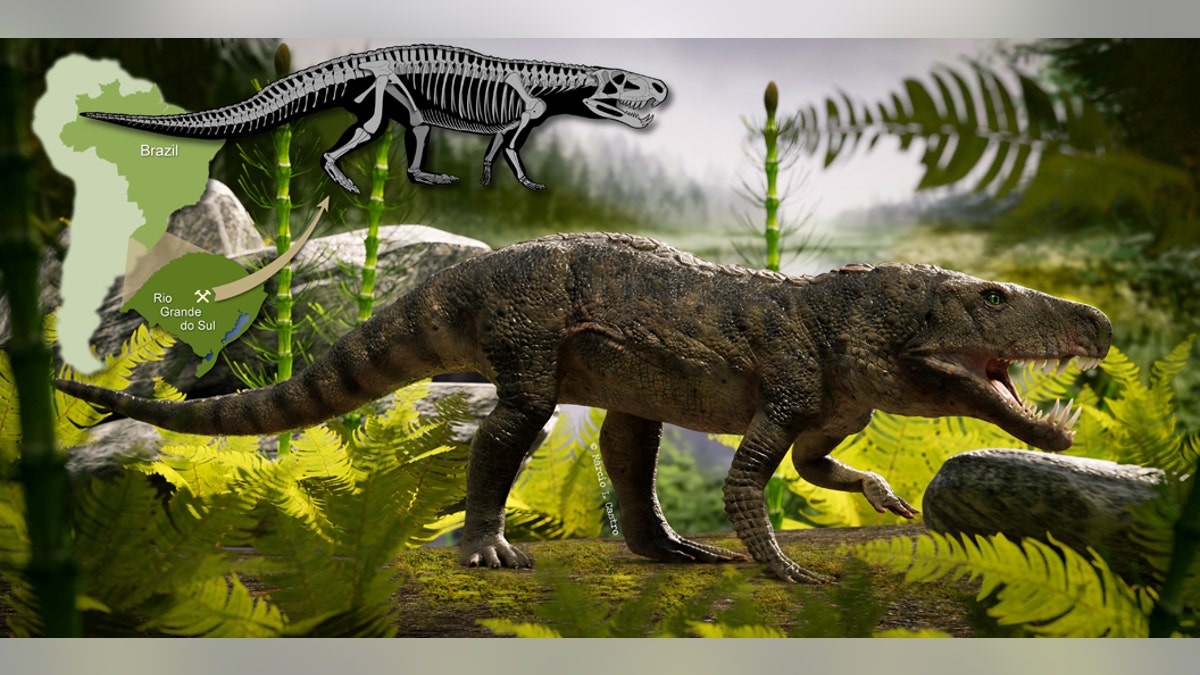'Bonecrushing' crocodile that hunted dinosaurs 230M years ago discovered in Brazil
Fossils of a 'bonecrushing' reptile that's related to the modern-day crocodile has been discovered in Brazil. The powerful scavenger that feasted on dinosaurs 230 million years ago was nicknamed the 'T. Rex of its time' by researchers.
The fossils of a "bonecrushing" ancestor of the modern-day crocodile that hunted dinosaurs 230 million years ago have been discovered in Brazil, stunning researchers.
Known as Dynamosuchus collisensis, the fossil was discovered in the dinosaur fossil hotbed of Agudo, in southern Brazil. It has been nicknamed the "T. Rex of its time," according to researchers. The study has been published in the scientific journal Acta Palaeontologica Polonica.
"The extremely rare reptile would have been a real bonecrusher from the 'dawn of the dinosaur era,'" the study's lead author, Rodrigo Müller, told British news outlet SWNS.

Dynamosuchus collisensis. A "bonecrushing" reptile that hunted dinosaurs 230 million years ago has been unearthed in the Brazilian rainforest. The terrifying creature, an ancestor of the crocodile, lived on land and was the 'T Rex of its time,' according to researchers. (Credit: SWNS)
WORLD'S OLDEST CARNIVOROUS DINOSAUR FOUND
Like modern-day crocodiles, D. collisensis walked on four legs, but it used its two hind legs to run, similar to the Tyrannosaurus rex. The creature was approximately seven feet long and had a long snout, massive jaws with blade-like teeth and claws that were used to rip apart its prey.
D. collisensis also had two rows of bony plates that ran down its back and a skull similar to that of T. rex. A study published in September 2019 stated the terrifying dinosaur had a stiff skull that allowed it to not shatter its own bones with its bite force, while simultaneously devouring its kill.
It's also believed that D. collisensis was a scavenger, a theory many paleontologists also have about the T. rex, looking for carcasses or smaller, easier-to-catch prey.
"Their large and blade-like teeth were adapted to eat meat. But the bite speed was low, suggesting it was also a scavenger," Müller explained.

The skull was similar to T Rex's - and a double row of bony plates ran down its back. It belonged to a group called the ornithosuchids. It is the fourth different species to be discovered. (Credit: SWNS)
"Therefore, this animal probably caught slow animals and searched for dead animals — like today's vultures and hyenas," Müller continued.
This is the fourth D. collisensis, which is a member of reptiles known as ornithosuchids, to be discovered. The first was discovered in Scotland in the 19th century and the other two were unearthed in Argentina, 50 years ago, Müller added.

First bone exposed. (Credit: SWNS)
That an ornithosuchid was discovered from the Late Triassic period in Brazil "suggests that ornithosuchids were more widespread than previously thought in the southern hemisphere," the researchers wrote in the study's abstract.
In November, researchers discovered the world's oldest carnivorous dinosaur, which also lived 230 million years ago, in southern Brazil.

